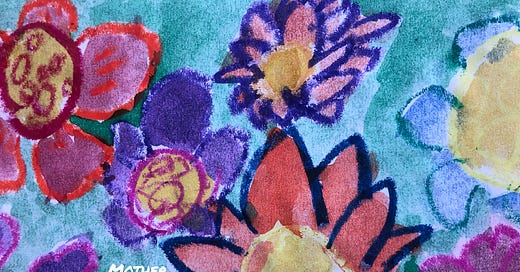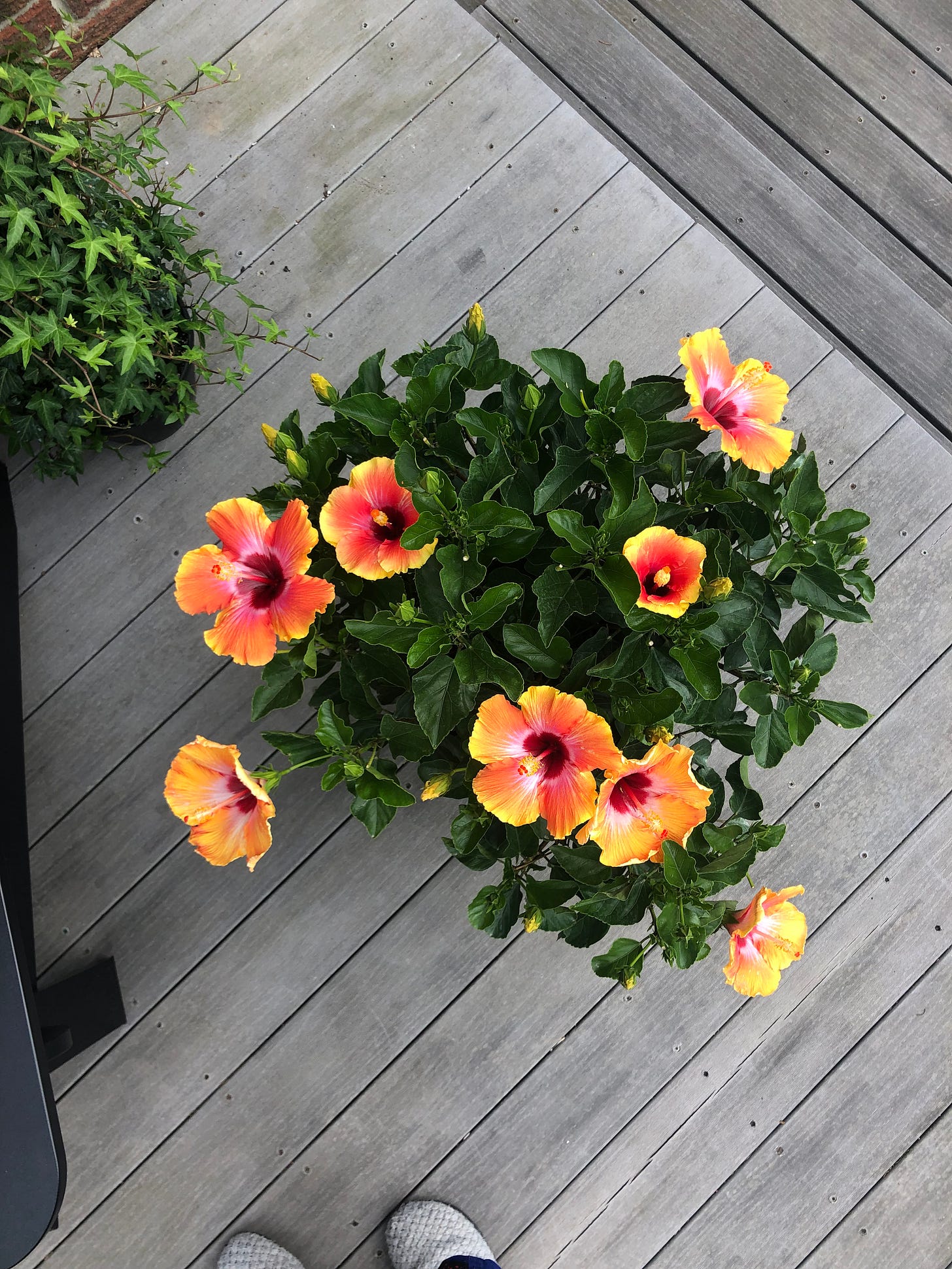Mother Nature's Curriculum on Creative Practice (Part 2 of 2)
Back to class and creative biomimicry
This is Part 2 of Mother Nature’s Curriculum on Creative Practice.
“Nature does not hurry, yet everything is accomplished.” - Lao Tzu
Nature is fascinating and magnificent and often completely relatable to human relationships, structures and processes. Below are five more examples of what plants can teach us about creative practice.
Tulips: Tulips are a colourful spectacle in early spring. But every year while my neighbours tulips are in full bloom, mine take a full week or two longer than their counterparts to arrive.
Tulips have two lessons to teach us:
Things will happen in their own time. Rushing the creative process is inefficient and ineffective, causing frustration along the way. Patience, optimism and consistency are traits that can replace rushing for a more fulfilling creative practice.
Lean into what feels right. Once our tulips bloomed, I noticed an incredible display taking place. At certain times of the day, the heads of the tulips leaned one way or another. I followed the direction of their leaning and I was met with the sun. Tulips literally lean into the energy source that fuels them. May we all lean in to the people, places and spaces — whether online or off — that fuel our energy rather than deplete it.
Dandelions: These pesky little weeds are an annoyance to most, especially those who pride themselves on having a beautiful lawn. However, dandelions have so much hidden wisdom to share, including:
Quantity counts. With any sort of creative endeavour, it’s not just quality that counts, quantity counts too. Making and doing and figuring it out as you go is only possible if you put in the work. No matter how weedy or annoying dandelions may seem, they’ve got the quantity thing figured out and we’d be wise to follow their lead in our own creative practices.
Grit is a choice. Pick a dandelion and another three will pop up in its place. Dandelions show us that we must keep going and that small acts produce huge results. The work ethic of dandelions is incredible. They experience multiple cycles of growth and sowing seeds all summer long, continuous action keeping dandelions on display through three of four seasons.
Community is critical. A single dandelion is a weed. A field of dandelions is a beautiful, yellow-spotted living tapestry. From an annoyance to an event, dandelions thrive as part of a larger community. There’s magic and connection to be found in the collective.
Three Bonus Plants
As I was looking through photos I’ve taken over the years, I found three non-spring-yet-highly-relevant plants to share.
Hibiscus: I bought this hibiscus plant on a whim because it was so magnificent. She was glorious so I named her Gloria. Gloria bloomed all summer 2022 and if you haven’t spent a lot of time around hibiscus plants (like me, before Gloria) you’ll be amazed to know that it takes each flower between 30-60 minutes to fully open, blooming only for the day and shrivelling up at night, never to be seen again. I was so enraptured by this dramatic process that I took a time lapse video of a bloom opening and I could see the flower moving, willing itself open in a high energy display.
Beautiful, tropical hibiscus plants have this to teach us:
You’re not only as good as your last output. A lot of energy is required to produce something beautiful. It’s ridiculous for me to expect that each new blossom must be more spectacular than the last, yet that’s often how we expect our own creativity to work. More is better. Better is better. Instead, it’s the incredible spectacle of opening and the limited time showing that makes this plant so special. There’s no need to judge the quality of each individual flower or place unnecessary pressure on the plant to be better and better with each bloom.
Rest is part of the process. Some days Gloria produced 10 or more blooms and some days it produced none. Much like our own creative practice, this plants’ outputs ebbed and flowed. On days that it didn’t produce flowers, I wasn’t mad or disappointed because I knew it would bloom again when the time was right.
The creative practice is the art. Almost as quickly as the blooms arrive, they’re gone, but the blooms themselves aren’t what’s most important. Instead, the entire process that contributed to the final bloom is the work of art. French painter, Yves Klein, viewed his work this way: “My paintings are only the ashes of my art.” The final output — the painting, the photograph, the drawing, the song, the dance and others — is merely the souvenir of our art. Instead, the creative practice and its inputs — curiosity, vulnerability, making connections, storytelling and others — is the art. It’s not the final Mother Nature’s Curriculum on Creative Practice that’s most important to me, but rather the idea, conceptualization, imagining, connections, growth and early morning writing with a soundtrack of orchestral birdsong out my window that are most important. Art need not be defined by what is produced, but rather the creative practice of who, where, when, how and why.
Mystery Plant: This is the weirdest and most wonderful plant I’ve ever seen. It looks like something strangely Seussian, with its vibrant colour, unusual texture and fantastical shape. And to this day, I still have no idea what it’s called. (I went so far as to do a reverse Google Image search to name it and even Google was stumped!)
I discovered this plant a couple of years ago when I often walked my daughters to a nearby pond in their stroller. The plant was growing out of the side of a Hydro box and it looked so out of place beside the weeds growing on either side of it that I couldn’t help but stop and stare. It fascinated me and I always made a point of admiring it.
The weirdest thing about this plant may not be its appearance or its placement, but rather the fact that it never returned.
Why did it grow? I’ll never know. Oh the places it could go.
Make a ruckus. (This is a favourite word of one of my favourite authors, Seth Godin.) This is exactly what the mystery plant did, showing up where it wasn’t invited, creating something of meaning for an audience who cares. For these reasons, it’s unforgettable.
Weird is wonderful! This plant looked nothing like the plants around it and nothing like I’d ever seen before. It was unique in every way, its weirdness something to be celebrated, not questioned or criticized. To extrapolate, the things that made us unique as kids — perhaps separating us from the herd of our peers — is precisely what our creative practice can highlight and celebrate as adults.
Christmas Cactus: This hearty, blooming succulent is an impressive specimen. The one you see in the photo above is a family heirloom, older than most members of my family. (Who ever thought about including a houseplant in a will?!). In fact, this healthy plant you see belonged not to my Grandmother, nor my Great Grandmother but my Great Great Grandmother. Yes, you read that right.
The most important lesson we can learn from this wise, old beauty is that creative longevity is rooted in practice, not performance. The fact that after 70+ years, it still blooms as magnificently as ever (maybe more so!) should have us pause and consider if our creative practice is so worthwhile and so important that we’ll want to do it for decades. It’s not that we have to create the same outputs, but rather that our practice is so fulfilling that we can see ourselves continuing to engage with creativity far into the future. If it feels more like work than play, it may be time to re-examine what and how and why we do it. May we engage, explore and experiment in a way that we can see ourselves wanting to do it for a long, long time.
I’m Rooting For You
There is so much to learn about creative practice from Mother Nature’s blossoming curriculum. Plants in early spring and beyond remind us that:
There are rewards for putting yourself out there before anyone else and being unapologetically vulnerable (Magnolia Trees)
Establishing systems to make habit formation easier can benefit our creative practice (Hostas)
Less is often more (Lilies)
Momentum builds over time and the results are worth the hard work of overcoming a steep learning curve (Solomon’s Seals)
Every day is a chance to reinvent oneself and sometimes it’s necessary to set down our creative practice but it will be there upon our return (Cherry Blossom Trees)
Things will happen in their own time and it’s important to lean into the energies that fuel us (Tulips)
Quantity counts in creative work, grit is a choice and community is critical (Dandelions)
You are not only as good as your last output, rest is part of the process and inputs of our creative practice are just as important as outputs (Hibiscus)
Make meaning for an audience who cares and weird is wonderful (Mystery Plant)
Creative practice should feel more like play than work; more like a process than a performance (Christmas Cactus)
The next time you’re out for a walk, pause and consider what plant life can teach us about creativity; the answers to human-made problems already solved through Mother Nature’s majesty and mysticism.










